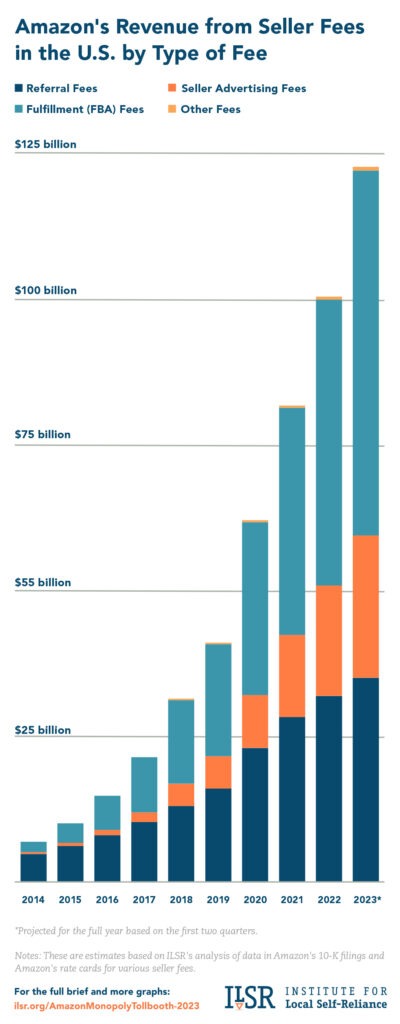Monopolies gonna monopoly. Now that Amazon is so dominant that many online retailers feel like they have no choice but to sell their products via them, Amazon squeezes them ever harder. At this point their fees represent almost half of the third-party sellers' revenue.
In the first half of 2023, using a variety of fees, Amazon took 45 percent of sellers’ revenue in the U.S. That’s up from 35 percent in 2020, and 19 percent in 2014.
Unsurprisingly, most of those businesses go on to fail.
The three main categories of costs are the:
-
Referral fee: usually 15% of the revenue. This was previously the only or main cost charged to sellers for listing their products on Amazon.
-
Advertising fees: which counter to many people’s intuition includes not only the more obvious adverts, but also the products Amazon highlights as “highly rated” and other such categories. You might think that the “highly rated” products are the products rated most highly on Amazon. But no - they’re the products someone is willing to pay to be featured. The consequences of this also affect their placement in the general Amazon search results. Apparently most sellers feel like they have to use these features to stand a chance of getting sales.
-
The fulfillment fees. These are charged for the privilege of having Amazon warehouse and ship your product. Most of the top sellers pay for this. Why? Because if not the products are not permitted to be eligible for Prime, which puts customers of - a new policy brought in 3 years ago. Because running 2 fulfilment services is expensive this tends to mean suppliers send their non-Amazon originating orders through “Fulfilled by Amazon” too, again increasing their take.
Amazon collects enough money from these fees - $82 billion in the first half of 2023 - such that it covers the entire cost of fulfilling both the third party orders and their own direct Amazon sales. Thus Amazon doesn’t need to consider warehousing and shipping costs for their own products, because the money they charge third party sellers to cover their fulfilment costs in fact also pays for Amazon’s own fulfilment costs. This is one reason why they can advantage themselves ever further by offering consumers lower prices than there is any hope that their rivals could match.

I don’t know how this next rule is legal, but sellers are also required to never charge less for their products on other sites than they do on Amazon if they want to sell anything on Amazon.
This means that sellers can’t pass the costs Amazon imposes on them to their own buyers who choose to use the Amazon ecosystem. Either they have to take the hit themselves, or they have to build the cost of operating with Amazon into the prices of every product they sell anywhere. This then either results in the business having to raises their prices to consumers irrespective of whether Amazon was involved or not, or making it that extra bit less likely for the business to survive for long enough to become sustainable.